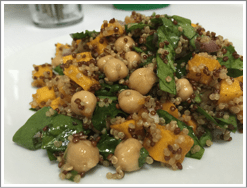By Lori Meszaros, ASU Nutrition Communication Student
Pumpkins have always been known for their amazing ability to withstand carving and of course to make a pie, but now pumpkin is popping up everywhere. From Starbucks’ world famous Pumpkin Spice Latte, to pumpkin bread, snacks and even beer.
It’s fall and that means pumpkin season.
Pumpkins are taking center stage in the produce section of your local grocery store and farmer’s markets. From small and ornamental to the giant carving, pumpkins are everywhere! And that’s a good thing because this fruit is actually a powerhouse when it comes to nutrition.
Nutritional benefits of Pumpkin
- Loaded with Vitamin A, one cup of pumpkin provides the body with over 200% of your RDA, which is needed to maintain healthy skin and eyes, boost your immune system, and help protect you during cold and flu season.
- Pumpkin is a rich source of the antioxidant beta-carotene, which helps prevent fine lines and wrinkles, and research supports the idea that pumpkin may play a role in cancer prevention.
- Pumpkins are high in Vitamins C and E
- Good source of fiber with more Potassium than a banana which is good for your heart. Fiber has been shown to reduce LDL “bad” cholesterol, and Potassium plays a crucial role in heart health.
- Pumpkins are a good source of complex carbohydrates, providing the body with an excellent source of energy. Helps regulate blood sugar due to low glycemic load which is important to anyone with diabetes.
- Research supports Pumpkin can help relieve the symptoms of arthritis due to its anti-inflammatory substances and has been shown to benefit the symptoms of bronchial asthma (Pitchford, 2002 & Yadav et al. 2010).
- 1 cup of pumpkin has only 49 calories and has no fat or cholesterol.
Adding pumpkin to your diet is easy and doesn’t just have to be limited to desserts and snacks. Try substituting your normal roasted vegetables with some roasted pumpkin. I love to add roasted pumpkin to my salads.
This Roasted Pumpkin and Chickpea Salad is one that I made for Thanksgiving dinner. I’m usually responsible for making the pumpkin pies, but last year I wanted to mix things up a bit. My guests loved the twist and were pleasantly surprised by the pumpkin making an appearance before dessert.
Roasted Pumpkin and Quinoa Salad

Ingredients
2 cups Butternut pumpkin/squash
2 cups Chickpeas, drained and rinsed
2 cups cooked quinoa
2 cups torn spinach
1 small red onion
1 tsp sea salt or rock salt
1 tsp chili powder (optional)
Marinade
2” piece ginger, peeled
1 garlic clove
1-2 small red chilies, deseeded if mild or leave in seeds for hot
1 tbsp. veggie stock concentrate or 1 bouillon cube crushed
⅓ cup water
Dressing
2 tbsp. balsamic vinegar
4-5 tbsp. cold pressed olive oil
1 tsp Dijon mustard
1 tsp agave nectar or honey
Method
- Preheat oven to 400F
- Start by preparing the marinade. Put all ingredients in a NutriBullet or high-speed blender. Blend until smooth.
- Cut pumpkin into bite size pieces, add to a mixing bowl with marinade and toss to coat.
- Place coated pumpkin on a cookie sheet lined with baking paper and bake until a fork inserts easily, approximately 10-15 minutes. Once cooked, remove and set aside to cool.
- To make the dressing, add all ingredients to a small bowl and whisk until emulsified, set aside.
- Add cooked pumpkin, chickpeas, quinoa, torn spinach and red onion a bowl, then toss with dressing.
The salad is best served at room temperature.
Enjoy!
This salad is also a great source of plant protein. Quinoa is the only grain, or seed depending on how you see it, that contains all 9 essential amino acids that are needed to make up a complete protein. In addition, quinoa is a good source of unsaturated fat that contains more calcium than milk, along with being a very good source of iron, phosphorous, B vitamins and vitamin E (Pitchford, 2002).
For more pumpkin recipes go to Fill Your Plate.
References
- American diabetes Association, Glycemic Index and Diabetes. Viewed October 5, 2016. http://www.diabetes.org/food-and-fitness/food/what-can-i-eat/understanding-carbohydrates/glycemic-index-and-diabetes.html
- Harvard Health Publications, Heart failure and potassium. Viewed October 6, 2016. http://www.health.harvard.edu/heart-health/heart-failure-and-potassium
- National Cancer Institute. Antioxidants and Cancer Prevention. Viewed October 5, 2016. https://www.cancer.gov/about-cancer/causes-prevention/risk/diet/antioxidants-fact-sheet
- Pitchford, P. Healing with whole foods, 3rd 2002. North Atlantic Books. Berkley, CA.
- Self-Nutrition Data, Pumpkin. Viewed October 5, 2016. http://nutritiondata.self.com/facts/vegetables-and-vegetable-products/2601/2
- How fiber protects your heart. Viewed October 6, 2016. http://www.webmd.com/diet/features/fiber-heart#1
- Yadav, M. et al. Medicinal and biological potential of pumpkin: an updated review. Nutr Res Rev, 2010; 23:184-190.

About Lori
Lori’s passion for food began when she was a little girl. Growing up on a small farm in Goodyear, AZ, she would follow her grandpa around the garden and watch her grandma in the kitchen. Lori’s curiosity and love for gardening and cooking led her down the path to pursue her passions. After studying Nutritional Medicine in Australia, and now studying Nutrition Communication at ASU, Lori plans to continue her studies to receive her Masters in Nutrition, taking her knowledge into the classroom to educate young minds about the importance of their food choices. Lori has strong beliefs that the food choices you make directly impact your health and eating local, fresh produce is the best prescription to better your health. Lori dedicates most of her free time to creating all of her favorite dishes with healthy, whole food ingredients in hopes to encourage future generations to live healthy, active lifestyles one meal at a time.

